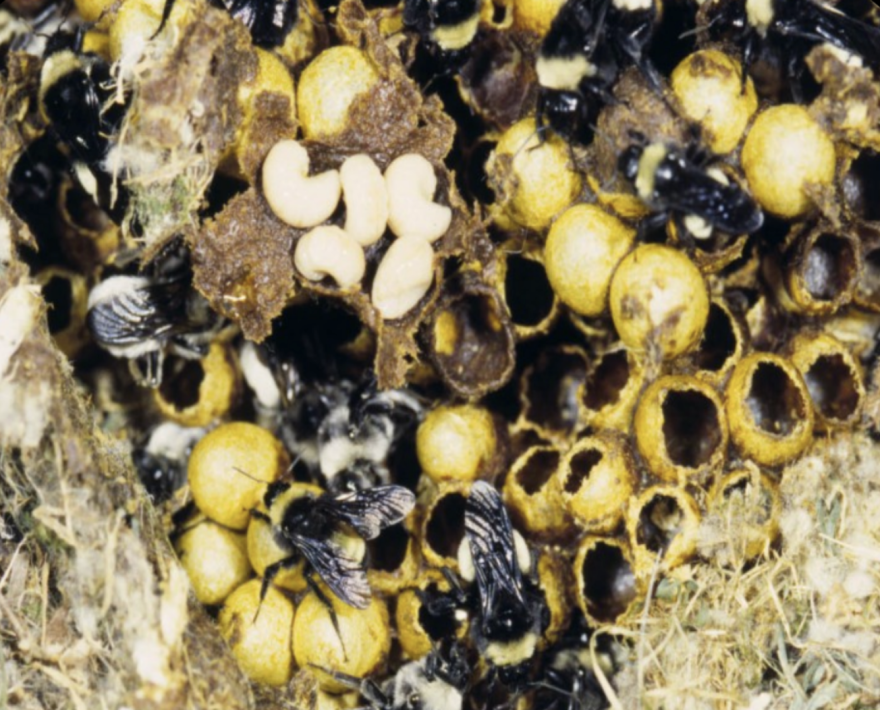Elaine Evans, a bee researcher with the University of Minnesota’s Bee Lab, joined the KAXE Morning Show to discuss Minnesota’s native bumblebees.
Evans appeared as part of the third conversation in KAXE's series about the decline of native pollinators.
Abstract art

Minnesota’s bees come in many different colors, shapes and life cycles. The most prominent among them are the bumblebees, which are large, fuzzy, and frequently seen. Unlike honeybees or wasps, native bumblebees do not build nests in a strict, orderly hexagonal pattern.
“It’s much more like abstract art,” Evans explained.
Bumblebees produce wax from abdominal glands used to create chambers: this wax is reused as the needs of the nest change. As larvae grow, wax is added, moved or reapportioned. The result is a nest constantly in flux, which Evans described as an “ever-changing structure.”
A yearly cycle: Fall and winter
Bumblebee survival is largely determined by the availability of resources during two critical periods: early spring and mid-fall. During these times, queen bees are on their own and searching for nectar and pollen above-ground.

In the fall, worker bees and old queen bees die off. The newly hatched queen bees leave the nest and must forage for food and locate a good overwintering spot. Goldenrod flowers provide a critical late-season boost to these queen bees. Evans suggested planting Canada goldenrod or showy goldenrod. Showy goldenrod doesn’t spread as quickly as Canada goldenrod, so would be best for smaller landscaping areas.
As temperatures chill, queen bees dig a few inches underground. Like many species of insects, they produce a natural form of antifreeze protecting their vital organs from damage. To protect these overwintering bees, delay disturbing the soil until warm weather returns in the spring.
Spring and summer
As queens emerge, they are hungry and must get a start on the new nesting season. They seek out flowering willows, maples, juneberries and spring ephemerals to sustain them as they begin building a nest. Often, the queen chooses an abandoned rodent burrow, which comes provisioned with adequate bedding and insulation. Planting early-season flowering plants like willows and maples will aid these spring queens as they feed and raise the first generation of worker bees.

During summer, the number of worker bees increases and the queen bee devotes her time to laying eggs. Interestingly, the queen regulates the size of the brood based on the amount of pollen available. Plants in the genus Monarda, such as beebalm and bergamot, are particular mid-summer favorites.
“These (pollen) resources really impact how big the colony can be and, most importantly, whether they’re able to produce new queens,” Evans said.
Raising a queen bee requires a lot of resources. However, without new queens, the colony will not reproduce and will die out in the winter.
People who are unable to create native plantings can help the bees by letting volunteer flowers flourish on their lawn.
“Things like dandelion and clover, there’s a lot of different bees that will use those plants and tolerating them in the lawn is something that I think, hopefully, we’ll move towards,” Evans said. “ … Landscapes and lawns haven’t been around forever. You know, we just got this idea in the mid-17th or 18th century that this was something that we liked. And, you know, there’s a good chance we can move away from it.”
Minnesota Bee Atlas

In addition to planting flowers (or allowing volunteers to flourish), Evans invites people to learn more about the Bee Atlas Project. This program trains volunteers to periodically survey baseball-field sized grid areas for active bees. Volunteers capture and photograph the bees, as well as record which flowers the bees are pollinating.
Using this data, the Bee Atlas has learned where different species live, in what density and what plant species are influential to their survival. Tri-colored bumblebees, for instance, are much more abundant in the northern half of Minnesota than the southern part of the state.
“We’ll be able to use those data in the future,” Evans said. “ ... There may be bumblebees that we think are common now. They might be declining in the future. We’ll be able to actually track that.”
To learn more about the Bee Atlas, visit mnbumblebeeatlas.umn.edu.
Funding for this project was provided by the Minnesota Environment and Natural Resources Trust Fund as recommended by the Legislative-Citizen Commission on Minnesota Resources (LCCMR).







